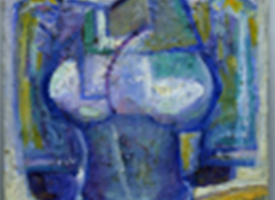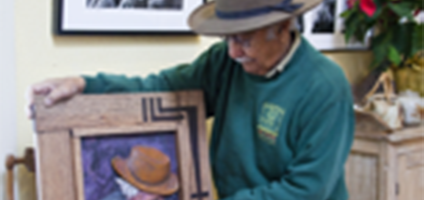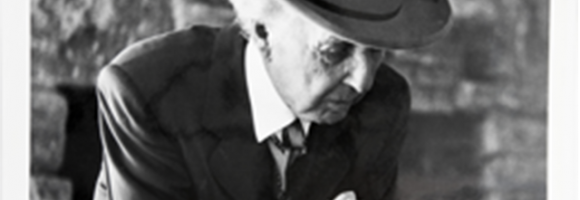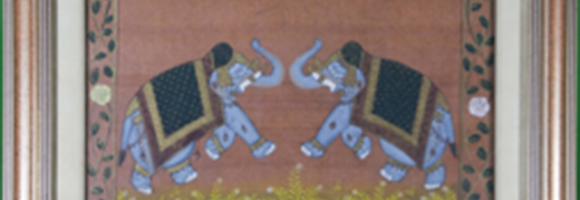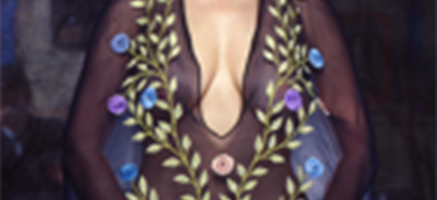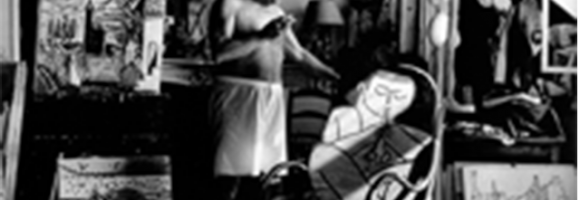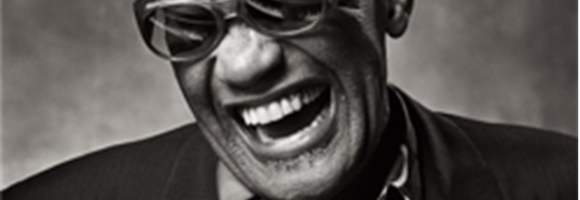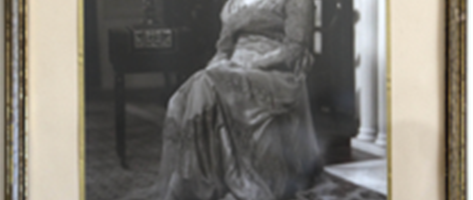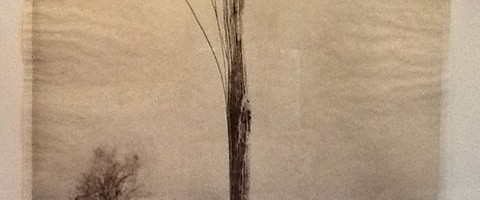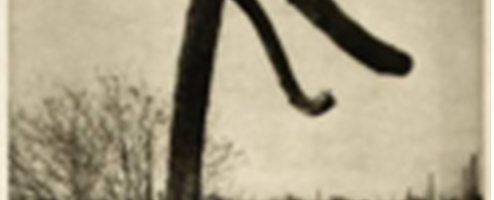Francis X. Nnaggenda
These paintings by Francis Nnaggenda are very significant to the arts program at Promega Corporation. The largest painting belonged to the original collection of about 60 paintings I brought from Kenya in 1995. The showing of these paintings, in addition to the large wooden sculpture of mother and child in the Promega BTC atrium, comprised the first exhibition I curated at the BTC.
The painting on canvas was created in response to the larger of the two. Many years ago, I bought and hand-delivered a roll of fine canvas, paints and brushes to Nnaggenda, in Uganda. I wanted to assure this painting could be created with the best materials, as they are hard to find in Africa. My hope is to sell this painting and send money back to Nnaggenda. The third, smaller, painting was a gift from the artist. Although this painting is very small it has “size.”
The mother and child wood carving located in the BTC Atrium originated from a tree culled from the woods near the North Promega Building in 1995. That year, we cut down a black walnut tree, placed it in my Ford F150 and drove it to Nnaggenda at Indiana University at South Bend (IUSB). He carved it there during his artist in residence, which I arranged. It took five weeks to complete and was on display at the IUSB Gallery for one day, after which it was returned here, where it has been on display since.
Daniel Swadener
This photograph of Frank Lloyd Wright is the first photo I purchased from Pedro Guerrero after meeting him in 2002, at his home in Florence, Arizona. Shortly after moving to Arizona, I knocked on his door and we became good friends.
It wasn’t until 2008 that I was able to exhibit the first retrospective of the photos of Pedro Guerrero at Promega Corporation. We celebrated Pedro’s 91st birthday at the reception, with at least 600 admirers in attendance.
In 2009, we exhibited the carvings of Tom Schlanker at Promega. I commissioned Tom to do a relief of Frank Lloyd Wright based on Pedro’s photo and took the carving to Pedro on my next visit to Florence, Arizona. I told Pedro he would either love the carving or sue me for copyright infringement.
As you can see from my photo of Pedro, he indeed liked Tom’s work and posed beneath his copy of the same photo at his home. I’m unsure if he consciously posed the way Wright did in the photo, but Pedro did happen to be wearing a fedora that day.
Honoring Pedro Guerrero was my proudest moment as a curator. Since his passing last year, one week after his 95th birthday, I have missed my friend and cherished our friendship.
Pedro Guerrero
This photograph of Frank Lloyd Wright is the first photo I purchased from Pedro Guerrero after meeting him in 2002, at his home in Florence, Arizona. Shortly after moving to Arizona, I knocked on his door and we became good friends.
It wasn’t until 2008 that I was able to exhibit the first retrospective of the photos of Pedro Guerrero at Promega Corporation. We celebrated Pedro’s 91st birthday at the reception, with at least 600 admirers in attendance.
In 2009, we exhibited the carvings of Tom Schlanker at Promega. I commissioned Tom to do a relief of Frank Lloyd Wright based on Pedro’s photo and took the carving to Pedro on my next visit to Florence, Arizona. I told Pedro he would either love the carving or sue me for copyright infringement.
As you can see from my photo of Pedro, he indeed liked Tom’s work and posed beneath his copy of the same photo at his home. I’m unsure if he consciously posed the way Wright did in the photo, but Pedro did happen to be wearing a fedora that day.
Honoring Pedro Guerrero was my proudest moment as a curator. Since his passing last year, one week after his 95th birthday, I have missed my friend and cherished our friendship.
Artist Unknown
I have enjoyed Persian Miniatures for a long time, not only because of the wonderful details they depict but for the cultural and historical value they embody. The tradition of Persian Miniatures dates back hundreds of years and continues today. The fine precision displayed in the Persian Miniature paintings is truly astonishing. These paintings are intricately done, yet because they are relatively common, most are valued at far less than they should be.
I collect from the heart and often learn about things by virtue of ownership. Thus, I do not know much about these items and their background. In the end, I’m just a caretaker for the art work, which will outlive me.
Learn more about Persian Miniatures.
John Becket
These three items are part of an assortment of Wyatt Earp works I have collected in the last fifteen years. Since moving to Arizona, I have been able to more thoroughly research Old West historians. Last year, Promega showcased historical photos of Arizona from the collection of Jeremy Rowe and Jeremy, for one, has written extensively about this photo of Wyatt Earp’s wife.
This photo, called Kaloma, depicts the woman thought to be the wife of Wyatt Earp. I found it in Greece in 1997 at an antique shop located in downtown Thessaloniki. The one displayed is a reproduction, since the original is too fragile to display for three months. The controversy about the true identity of the woman depicted in the photo is typical of Old West lore and embellishments of the truth about that time in our history.
The photograph of Jennifer Tilly posing in reflection of Kaloma is by John Beckett. This and other shots from the same photo shoot can be found in the issue of True West magazine currently located in the Promega library. This issue of True West was the fastest selling issue they have ever had.
I own various books and a collection of over 600 negatives from Tombstone, AZ circa 1915. I have been working with the Historical Society there to preserve these images. Last year I stayed at an RV camp in Tombstone. It took me about one hour of sitting on a bench and talking to locals to connect with just about everyone who claimed to be an expert of the history of The Shootout at the OK Corral nearby. Tombstone, “The Town Too Tough to Die,” is my favorite bit of Americana.
Andre Villers
I acquired this photograph in 2012 from an auction in Scottsdale, Arizona. When I contacted the photographer, Andre Villers, he kindly sent me detailed information about this photograph, down to the type of paper it is printed on.
Andre first met Picasso in 1952 and went on to photograph many famous artists. His tuberculosis has prevented him from traveling, but luckily the South of France has attracted many artists to photograph.
Although Andre’s illness prevents him from coming to the United States, I hope to visit him in the City of Mougins, France in the near future and to bring his amazing exhibition of images of Pablo Picasso to be displayed in the United States.
Norman Seeff
I came across this photograph at the estate sale of Sherman Darby, tour manager for B.B. King. This image was used as the cover of Ray Charles’ last CD, “Genius Loves Company.” Because one of the cuts featured B.B. King, I venture to guess this photo was given to King for his work on the CD.
I had the opportunity to speak with Norman Seeff shortly after I made this purchase.
Norman was impressed by the creativity and dedication of Bill Linton and Promega Corporation and invited me to visit his studio to discuss the possibility of exhibiting some of his photos. Bill and I had the privilege of meeting with him in Burbank earlier this year, and I am now working with Norman to bring an exhibition of his photographs to Madison, WI next year.
This link tells more of the story.
Edward Curtis
I happened upon the first photograph, the Curtis photograph of the seated woman, at an outdoor flea market in Scottsdale, Arizona. It was positioned on the ground next to a table facing the sun, and as an art curator, my instinct was to protect any photo from direct sunlight.
I bought the photograph for only ten dollars, recognizing the Edward Curtis signature. Edward Curtis photographed wealthy individuals to sustain the immense costs of his life’s work, recording the faces and lifestyles of over eighty vanishing Native American tribes, something he did between 1904 and 1930. Although the identity of the woman remains unknown, my research and several historians have eliminated some possibilities. This image may depict one of his wealthy clients.
The second photo, “On the Old Well of Acoma,” was printed in 1974 from the original copper plate. Jean-Antony du Lac printed a series of Curtis photographs, which are said to be undistinguishable from the originals.
Mark Klett
These two photos are part of a suite of three from an addition of 40. I acquired these at an estate sale years ago. The man running the sale knew nothing of the missing third image and had little information about the photos. Needless to say, I bought them for a great price.
Having curated an exhibition of Mark’s works at Promega in the fall of 2006, I knew him well and was quite familiar with his artwork. Upon arriving home, I contacted Mark and told him what I had purchased. He invited me to his home, whereupon he offered to sell me the book that goes with the images. This book, titled Mark Klett: Saguaros, is long out of print and one of few left, making it and these photographs a precious part of my collection.
Of all the great photos and books Mark Klett has made, the only photos he has in his home are from this set. The beautiful copper plates used in the making of the three photogravures are also currently being used by the artist himself, as splash guards for his kitchen stove. He could not bring himself to dispose of these special items.
On my way out of Mark’s house, he gave me another book titled The Black Rock Desert. I went to Burning Man Festival for the first time about a month later and read the book there. Coincidently, this book was about Mark’s journey to the spot where Burning Man takes place. The event is known for leaving no trace; Mark’s goal was to find the Burning Man site and to test that assertion. He did so and found nothing.
Mark Klett uses his photography to talk about who we are in space and time. He is more than a photographer – he depicts reality reflecting how we perceive it. I feel honored to have his items in my collection and am proud to know Mark as a friend and as one of the most talented living photographers in the world.
To learn more about Mark Klett’s work, click here.
Mark Klett
These two photos are part of a suite of three from an addition of 40. I acquired these at an estate sale years ago. The man running the sale knew nothing of the missing third image and had little information about the photos. Needless to say, I bought them for a great price.
Having curated an exhibition of Mark’s works at Promega in the fall of 2006, I knew him well and was quite familiar with his artwork. Upon arriving home, I contacted Mark and told him what I had purchased. He invited me to his home, whereupon he offered to sell me the book that goes with the images. This book, titled Mark Klett: Saguaros, is long out of print and one of few left, making it and these photographs a precious part of my collection.
Of all the great photos and books Mark Klett has made, the only photos he has in his home are from this set. The beautiful copper plates used in the making of the three photogravures are also currently being used by the artist himself, as splash guards for his kitchen stove. He could not bring himself to dispose of these special items.
On my way out of Mark’s house, he gave me another book titled The Black Rock Desert. I went to Burning Man Festival for the first time about a month later and read the book there. Coincidently, this book was about Mark’s journey to the spot where Burning Man takes place. The event is known for leaving no trace; Mark’s goal was to find the Burning Man site and to test that assertion. He did so and found nothing.
Mark Klett uses his photography to talk about who we are in space and time. He is more than a photographer – he depicts reality reflecting how we perceive it. I feel honored to have his items in my collection and am proud to know Mark as a friend and as one of the most talented living photographers in the world.
To learn more about Mark Klett’s work, click here.
